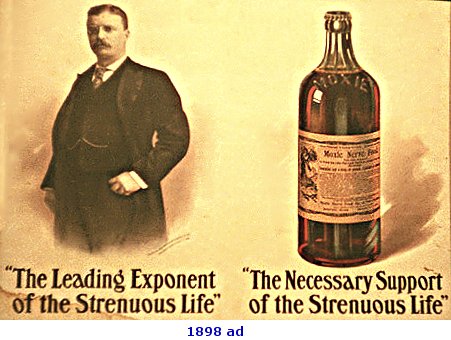
Thursday, November 17, 2005
Page 15
REMINISCING (Column)
Is Hires the Longest Marketed Soft Drink? Or Moxie? Or...?
By ROGER M. GRACE
Vernors Ginger Ale. Hires Root Beer. Dr Pepper. Each of these soft drinks is identified at various spots on the Internet as the nation’s oldest soft drink brand.
As far as when the drinks were developed:
•It was apparently in 1866 that James Vernor first added his ginger extract, which had aged four years in a barrel, to a glass of soda water. He began selling his drink in that year, or at least soon after that, to patrons of his Detroit drug store.
•The contention that druggist Charles E. Hires created his root beer on May 16, 1866 is oft-repeated, but appears to lack substantiation—or credibility (given that he was 14 at that time and supposedly derived the recipe from an herbal tea he encountered on his honeymoon). Hires’ root beer sales at his Philadelphia establishment began at some unknown time during or prior to the mid-1870s.
•It’s said to have been in 1885 that W.B. Morrison began selling Dr. Pepper, a cola-like berry-based drink, at the “Old Corner Drug Store” in Waco, Texas. (A period was inserted after “Dr.” until 1955 when the maker apparently wanted to disavow any implied claim to the drink having medicinal properties.)
Of these three venerable soft drinks—all now owned by Cadbury/Schweppes—Vernors is the brand with the earliest beginnings.
What of the claim of Hires Root Beer that it’s “the oldest continuously marketed soft drink in the United States”?
Charles Hires was an exhibitor at the 1876 U.S. Centennial Exposition, and is believed to have served glasses of root beer there. However, it would be incorrect to use 1876 as the starting date for Hires Root Beer.
Although Charles Neubauer, national sales manager for Hires Beverages International, was quoted in a newspaper on Aug. 14, 1969 as saying that “Hires Root Beer has been a favorite across the U.S. since 1876,” the fact is that what Charles Hires started marketing in 1877—and on considerably less than a national scale—was a root beer mix.
Sales of Hires’ ready-to-drink root beer, contained in bottles, are generally thought to have started in 1893. That beats Vernors, which began its bottling operations no earlier than 1896 (when James Vernor closed his drug store and began focusing exclusively on his beverage business).
Dr. Pepper was first bottled in 1891—but there’s some doubt as to whether it’s been “continuously” produced since then...to be dealt with in a subsequent column.
A rival contender for the distinction of being the “the oldest continuously marketed soft drink in the United States” is Moxie.
The Monarch Beverage Company of Atlanta, Ga., which manufactures Dad’s Old Fashioned Root Beer, also makes Moxie, a beverage once quite popular nationally but now, for the most part, relegated to East Coast outlets. Monarch’s website proclaims:
“Introduced in 1884, Moxie was the original soft drink in the United States. In fact, the word ‘moxie,’ which means ‘energy’ or ‘pep,’ originated with the Moxie soft drink brand....
“Moxie
was first marketed in 1876 as a medicine by a doctor in Maine
who guaranteed it to cure multiple ills.”
|
|
Weighing against a recognition of Moxie’s claim is that when it was introduced in beverage form in 1884—or 1885, according to its patent application that year—it was marketed as an elixir, not a soft drink. Dr. Augustin Thompson, a Massachusetts homeopathic physician, filed that application, which included his declaration setting forth:
“This trade-mark I have used continuously in my business since April 1, 1885, and the particular description of goods is a liquid preparation charged with soda for the cure of paralysis, softening of the brain, and mental imbecility, and called the ‘Moxie Nerve Food.’ It is comprised in the class of medical compounds.”
On the other hand, the beverage was a “soft” drink, in the sense that it was non-alcoholic and, being “charged with soda,” was a form of “soda pop.” (The term “pop” is derived from the sound resulting when a cork is removed from a bottle.)
According to a 1907 U.S. District Court opinion, Thompson—whose credentials as a medical practitioner were much in doubt—lent money to a tonic beer factory “and subsequently took possession of the property in satisfaction of his debt, and continued the same business.” Moxie, the opinion said, “was apparently the result of variations of or additions to the formula for ordinary root or tonic beer, so-called.”
Thus, although Moxie was sold as a virtual cure-all, it was, in reality, a soft drink, though not popularly perceived of as such until the early 1900s.
Factors militating in favor of recognizing the pre-1900s product as a refreshment, not just an elixir, are its packaging in the form of a champagne bottle, placement of it by some grocers alongside ginger ale and the like, and reference to it in ads in 1885 as the “best beverage in America.”
The competition for the title of “oldest brand” is not merely between Hires and Moxie. Next week: a look at Dr. Brown’s Cel-Ray, launched in 1869, and at an obscure sparkling cider apparently on the market since 1849.
Copyright 2005, Metropolitan News Company